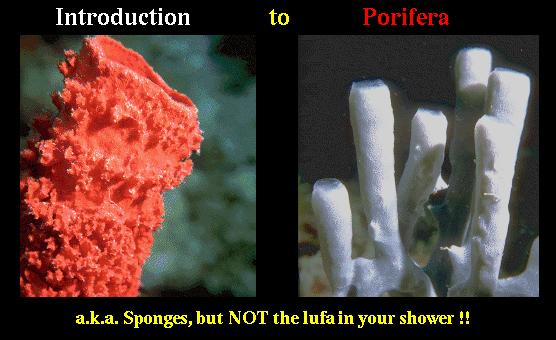Phylum Porifera
General features of phylum Porifera:
They are mostly marine and non-motile.
They are mostly found attached to rocks.
They show cellular level of organization. Their body is not organized into tissues and organs.
- Their bodies are porous. Their bodies has holes or pores all over, which allows the circulation of water throughout the body and bring in food and oxygen.
- 7
Cellular level of organization, without true tissues
• Adults exhibit radial symmetry or are asymmetrical
• Possess totipotent cells
• Possess unique flagellated cells – choanocytes – that
create water flow through a water current system
• Outer and inner cell layers lack a basement membrane
• Outer and inner cell layers divided by a noncellular layer
– the mesohyl – that contains some cells and skeletal
material
• Body support (“skeleton”) provided by spicules
composed of calcium carbonate or silicon
Cheers!!
- 1

Poriferans are commonly referred to as sponges. An early branching event in the history of animals separated the sponges from other metazoans. As one would expect based on their phylogenetic position, fossil sponges are among the oldest known animal fossils, dating from the Late Precambrian. Since then, sponges have been conspicuous members of many fossil communities; the number of described fossil genera exceeds 900. The approximately 5,000 living sponge species are classified in the phylum Porifera, which is composed of three distinct groups, the Hexactinellida (glass sponges), the Demospongia, and the Calcarea (calcareous sponges).Sponges are characterized by the possession of a feeding system unique among animals. Poriferans don't have mouths; instead, they have tiny pores in their outer walls through which water is drawn. Cells in the sponge walls filter goodies from the water as the water is pumped through the body and out other larger openings. The flow of water through the sponge is unidirectional, driven by the beating of flagella which line the surface of chambers connected by a series of canals. Sponge cells perform a variety of bodily functions and appear to be more independent of each other than are the cells of other animals

Clathria basilana
Phylum Porifera: Sponges |
Reproduction in Sponges |
1.) fragments that break off from the parent animal may become new sponges
OR
2.) gemmules: collections of amoebocytes within a hard, protective outer layer
Most kinds of sponges are hermaphrodites, meaning the same individual has both male and female reproductive structures and produces both sperm and egg cells. This is a great advantage for animals with little or no motilitty, as a hermaphrodite can mate with any partner, with no limitations concerning gender.
- 1
eg: Sycon, Spongilla, Euplecata.
they mostly have porous body and mostly known as Ostia.
They have inter connected network of system called canal system.water ,food,oxygen enters the body through ostia and reaches body cavity.tiny food particles are filtered out and water goes outsited through Osculum with carbon did oxide and waste.
cellular level of organisation.
body wall is made up of hard covering of spicules and in turn made up of calcium carbonate or silica.
they are diploblastic i.e they have two germ layers.....
-ectoderm
-endoderm
mostly marine.
non-motile.
mostly show radial symmetry.
- 0
PORIFERA : . A phylum of aquatic invertebrate animals that comprises the sponges
coelenterata: An aquatic invertebrate animal of a phylum that includes jellyfishes, corals, and sea anemones. They are distinguished by having a tube- or cup-shaped body and a single opening ringed with tentacles
- 0

